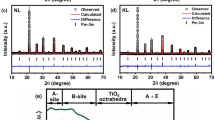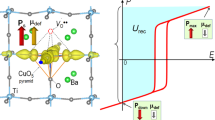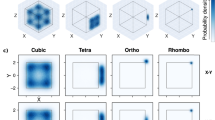Abstract
BARIUM TITANATE and certain related compounds having structures of the perovskite type possess exceptionally high permittivities which rise to a maximum at certain characteristic temperatures, a transition taking place from a distorted to a cubic crystal structure. The permittivity – temperature relation depends primarily on the particular material used, but is influenced also by the method of preparation, especially by the temperature at which the ceramic is fired. It has been shown that barium titanate is ferro-electric below the temperature corresponding to its permittivity maximum1,2, and in this connexion a study of the changes with time in the permittivity and dielectric losses after a high, unidirectional electric field had been applied to materials of this type, which is now described in outline, may be of interest.
This is a preview of subscription content, access via your institution
Access options
Subscribe to this journal
Receive 51 print issues and online access
$199.00 per year
only $3.90 per issue
Buy this article
- Purchase on SpringerLink
- Instant access to full article PDF
Prices may be subject to local taxes which are calculated during checkout
Similar content being viewed by others
References
J. Phys., U.S.S.R., 10, 95 (1946).
Ind. Eng. Chem., 38, 1097 (1946).
Trans. Farad. Soc., 42, 224 (1946).
Nature, 160, 58 (1947).
Author information
Authors and Affiliations
Rights and permissions
About this article
Cite this article
PARTINGTON, J., PLANER, G. & BOSWELL, I. Dielectric Residual Effects in Titanates. Nature 160, 877–878 (1947). https://doi.org/10.1038/160877a0
Issue date:
DOI: https://doi.org/10.1038/160877a0
This article is cited by
-
Voltage Effects in Titanate Polycrystals
Nature (1948)



